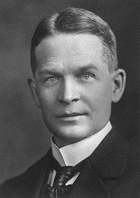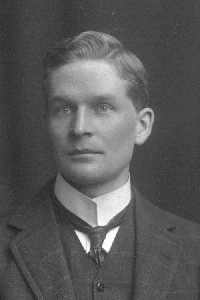<Back to Index>
- Radiochemist Frederick Soddy, 1877
- Architect Vincenzo Scamozzi, 1548
- King of Holland Louis Napoléon Bonaparte, 1778


Frederick Soddy (2 September 1877 – 22 September 1956) was an English radiochemist who explained, with Ernest Rutherford, that radioactivity is due to the transmutation of elements, now known to involve nuclear reactions. He also proved the existence of isotopes of certain radioactive elements. He received the Nobel Prize for Chemistry in 1921, and has a crater named for him on the far side of the Moon.
Soddy was born in Eastbourne, England. He went to school at Eastbourne College, before going on to study at University College of Wales at Aberystwyth and at Merton College, Oxford. He was a researcher at Oxford from 1898 to 1900. He married Winifred Beilby in 1908.
In 1900 he became a demonstrator in chemistry at McGill University in Montreal, Quebec, Canada, where he worked with Ernest Rutherford on radioactivity. He and Rutherford realized that the anomalous behaviour of radioactive elements was because they decayed into other elements. This decay also produced alpha, beta, and gamma radiation. When radioactivity was first discovered, no one was sure what the cause was. It needed careful work by Soddy and Rutherford to prove that atomic transmutation was in fact occurring.
His work and essays popularising the new understanding of radioactivity was the main inspiration for H.G. Wells's The World Set Free (1914), which features atomic bombs dropped from biplanes in a war set many years in the future. Wells's novel is also known as The Last War and imagines a peaceful world emerging from the chaos. In Wealth, Virtual Wealth and Debt Soddy praises Wells’s The World Set Free. He also says that radioactive processes probably power the stars.
In 1903, with Sir William Ramsay at University College London, Soddy verified that the decay of radium produced alpha particles composed of positively charged nuclei of helium. In the experiment a sample of radium was enclosed in a thin walled glass envelope sited within an evacuated glass bulb. Alpha particles could pass through the thin glass wall but were contained within the surrounding glass envelope. After leaving the experiment running for a long period of time a spectral analysis of the contents of the former evacuated space revealed the presence of helium. This element had recently been discovered in the solar spectrum by Bunsen and Kirchoff.
From 1904 to 1914, Soddy was a lecturer at the University of Glasgow and while there he showed that uranium decays to radium. It was here also that he showed that a radioactive element may have more than one atomic mass though the chemical properties are identical. He named this concept isotope meaning 'same place' - the word 'isotope' was initially suggested to him by Margaret Todd. Later, J.J. Thomson showed that non-radioactive elements can also have multiple isotopes. Soddy also showed that an atom moves lower in atomic number by two places on alpha emission, higher by one place on beta emission. This was a fundamental step toward understanding the relationships among families of radioactive elements.
Soddy published The Interpretation of Radium (1909) and Atomic Transmutation (1953). In 1914 he was appointed to a chair at the University of Aberdeen, where he worked on research related to World War I. In 1919 he moved to Oxford University as Dr Lee's Professor of Chemistry, where, in the period up till 1936, he reorganized the laboratories and the syllabus in chemistry. He received the 1921 Nobel Prize in chemistry for his research in radioactive decay and particularly for his formulation of the theory of isotopes.
In four books written from 1921 to 1934, Soddy carried on a "quixotic campaign for a radical restructuring of global monetary relationships", offering a perspective on economics rooted in physics — the laws of thermodynamics, in particular — and was "roundly dismissed as a crank". While most of his proposals - "to abandon the gold standard, let international exchange rates float, use federal surpluses and deficits as macroeconomic policy tools that could counter cyclical trends, and establish bureaus of economic statistics (including a consumer price index) in order to facilitate this effort" - are now conventional practice, his critique of fractional-reserve banking still "remains outside the bounds of conventional wisdom".
He rediscovered the Descartes' theorem in 1936 and published it as a poem. The kissing circles in this problem are sometimes known as Soddy circles. The lunar crater Soddy is named after him. He died in Brighton, England.